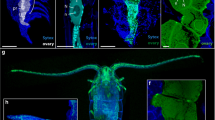Summary
The embryo ofSabellaria cementarium (Polychaeta) forms a polar lobe at each of the first two cleavage divisions which becomes absorbed into one of the blastomeres at the end of the division. Lobe removal experiments show that the polar lobe preceding first cleavage is necessary for the development of the apical tuft and the posttrochal region of the trochophore larva. The polar lobe preceding second cleavage is smaller than the first polar lobe and is necessary only for post-trochal region development. In blastomere isolation experiments, isolates containing the C but not the D blastomere form apical tufts. Isolates containing the D but not the C blastomere do not form apical tufts. When the polar lobe preceding second cleavage is removed and the C and D blastomeres are separated and raised in isolation, each can form an apical tuft. When the second cleavage is equalized with sodium dodecyl sulfate (SDS) such that both the C and the D blastomeres receive second polar lobe material, no apical tuft is formed. These results suggest that apical tuft determinants are distributed to both the C and D blastomeres at second cleavage but that the second polar lobe contains an inhibitor for apical tuft formation which is shunted to the D blastomere after the completion of second cleavage.
Similar content being viewed by others
References
Biggelaar JAM van den (1978) The determinative significance of the geometry of the cell contacts in early molluscan development. Biol Cell 32:155–161
Cather JN (1967) Cellular interactions in the development of the shell gland of the gastropod,Ilyanassa. J Exp Zool 166:205–224
Cather JN (1973) Regulation of apical cilia development by the polar lobe ofIlyanassa (Gastropoda: Nassariidae) Malacologia 12(2):213–223
Cather JN, Verdonk NH (1979) Development ofDentalium following removal of D-quadrant blastomeres at successive cleavage stages. Wilhelm Roux's Arch 187:355–366
Child CM (1900) The early development ofArenicola andSternaspis. Arkiv Entw Mech Org 9:587–723
Clement AC (1952) Experimental studies on germinal localization inIlyanassa. 1. The role of the polar lobe in determination of the cleavage pattern and its influence in later development. J Exp Zool 121:593–625
Clement AC (1960) Development of theIlyanassa embryo after removal of the mesentoblast cell. Biol Bull 119:310
Clement AC (1962) Development ofIlyanassa following removal of the D macromere at successive cleavage stages. J Exp Zool 149:193–216
Clement AC (1968) Development of the vegetal half of theIlyanassa egg after removal of most of the yolk by centrifugal force, compared with the development of animal halves of similar visible composition. Dev Biol 17:165–186
Conrad GW (1973) Control of polar lobe formation in fertilized eggs ofIlyanassa obsoleta Stimpson. Am Zool 13:964–980
Crampton HE (1896) Experimental studies on gasteropod development. Arkiv Ent Mech Org 3:1–19
Davidson EH (1976) Localization of morphogenetic determinants in egg cytoplasm. In: Gene activity in early development. Academic Press, New York, pp. 249–318
Dongen CAM van (1976) The development ofDentalium with special reference to the significance of the polar lobe. V and VI. Differentiation of the cell pattern in lobeless embryos ofDentalium vulgare (da Costa) during late larval development. Proc K ned Akad Wet C79:245–266
Eckelbarger KJ (1976) Larval development and population aspects of the reef-building polychaetePhragmatopoma lapidosa from the east coast of Florida. Bull Mar Sci 26:117–132
Freeman G (1979) The multiple roles which cell division can play in the localization of developmental potential. In: Subtelny S, Konigsberg IR (eds) Determinants of spatial organization. Academic Press, New York, pp. 53–76
Geilenkirchen WLM, Verdonk NH, Timmermans LPM (1970) Experimental studies on morphogenetic factors localization in the first and the second polar lobe ofDentalium eggs. J Embryol Exp Morphol 23 (1):237–243
Guerrier P (1970) Les caractères de la segmentation et la détermination de la polarité dorsoventrale dans le developpement de quelques Spiralia II.Sabellaria alveolata (Annélide polychète). J Embryol Exp Morphol 23 (3):639–665
Guerrier P, Biggelaar JAM van den, Dongen CAM van, Verdonk NH (1978) Significance of the polar lobe for the determination of dorsoventral polarity inDentalium vulgare (da Costa) Dev Biol 63:233–242
Hatt P (1932) Essais experimentaux sur les localizations germinales dans l'oeuf d'un annelide (Sabellaria alveolata L.. Arch d'Anat Micros 28:81–98
Kozloff EN (1974) Keys to the Marine Invertebrates of Puget Sound, the San Juan Archipelago and Adjacent Regions. University of Washington Press, Seattle
Lacalli TC (1981) Structure and development of the apical organ in trochophores ofSpirobranchus polycerus, Phyllodoce maculata andPhyllodoce mucosa (Polychaeta). Proc R Soc (Lond) 212:381–402
Novikoff AB (1938a) Embryonic determination in the annelid,Sabellaria vulgaris I. The differentiation of ectoderm and endoderm when separated through induced exogastrulation. Biol Bull 74:198–210
Novikoff AB (1938b) Embryonic determination in the annelid,Sabellaria vulgaris. II. Transplantation of polar lobes and blastomeres as a test of their inducing capacities. Biol Bull 74:211–234
Novikoff AB (1940) Morphogenetic substances or organizers in annelid development. J Exp Zool 85:127–151
Tanaka Y (1976) Effects of the surfactants on the cleavage and further development of the sea urchin embryos. 1. The inhibition of micromere formation at the fourth cleavage. Dev Growith Diff 18:113–122
Tyler A (1930) Experimental production of double embryos in annelids and molluscs. J Exp Zool 57(3):347–407
Verdonk NH (1968) The effect of removing the first polar lobe in centrifuged eggs ofDentalium. J Embryol Exp Morphol 19:33–42
Wilson DP (1929) The larvae of the British sabellarians. J Mar Biol Assn 15:221–269
Wilson EB (1904) Experimental studies on germinal localization 1. The germ-regions in the egg ofDentalium. J Exp Zool 1:1–72
Wilson EB (1925) Development and heredity. In: The cell in development and heredity. Macmillan, New York, pp 1035–1121
Winesdorfer JE (1967) Marine annelids:Sabellaria. In: Wilt FH, Wessels NK (eds) Methods in developmental biology. TY Crowell, New York, pp. 157–162
Author information
Authors and Affiliations
Rights and permissions
About this article
Cite this article
Render, J.A. The second polar lobe of theSabellaria cementarium embryo plays an inhibitory role in apical tuft formation. Wilhelm Roux' Archiv 192, 120–129 (1983). https://doi.org/10.1007/BF00848680
Received:
Accepted:
Issue Date:
DOI: https://doi.org/10.1007/BF00848680




